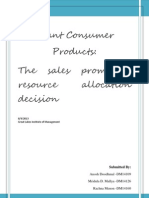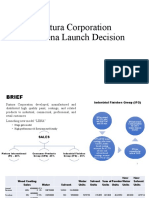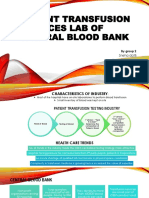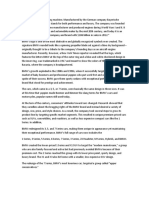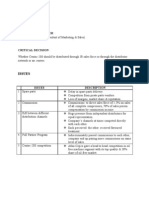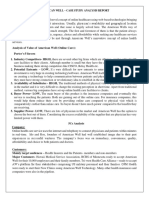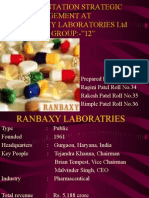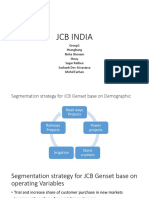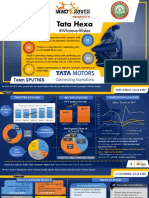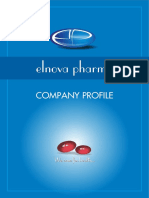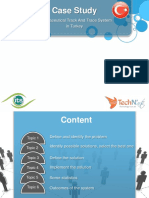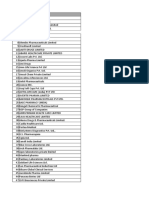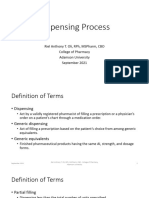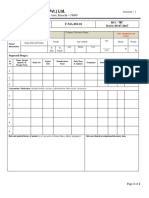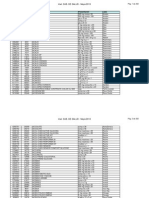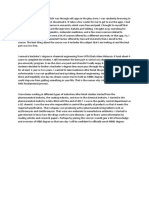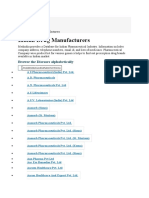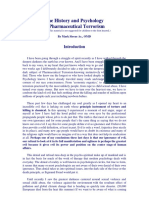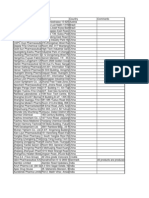100%(1)100% found this document useful (1 vote)
145 viewsSecB Grp1 B2B Dendrite
SecB Grp1 B2B Dendrite
Uploaded by
Hrangbung DarthangDendrite International is a leading software supplier to the pharmaceutical industry that started in 1985. It has a presence in 11 countries with 15,000 salespeople across 40 companies. However, changing market conditions like increased healthcare costs and centralized buying are reducing the number of sales reps needed. The document analyzes Dendrite's customers, competition, and available alternatives to expand into new markets. It recommends Dendrite expand into other vertical areas within pharmaceutical firms like marketing and customer service to leverage their expertise and customizable software systems.
Copyright:
© All Rights Reserved
Available Formats
Download as PPT, PDF, TXT or read online from Scribd
SecB Grp1 B2B Dendrite
SecB Grp1 B2B Dendrite
Uploaded by
Hrangbung Darthang100%(1)100% found this document useful (1 vote)
145 views10 pagesDendrite International is a leading software supplier to the pharmaceutical industry that started in 1985. It has a presence in 11 countries with 15,000 salespeople across 40 companies. However, changing market conditions like increased healthcare costs and centralized buying are reducing the number of sales reps needed. The document analyzes Dendrite's customers, competition, and available alternatives to expand into new markets. It recommends Dendrite expand into other vertical areas within pharmaceutical firms like marketing and customer service to leverage their expertise and customizable software systems.
Original Description:
Dendrite case
Copyright
© © All Rights Reserved
Available Formats
PPT, PDF, TXT or read online from Scribd
Share this document
Did you find this document useful?
Is this content inappropriate?
Dendrite International is a leading software supplier to the pharmaceutical industry that started in 1985. It has a presence in 11 countries with 15,000 salespeople across 40 companies. However, changing market conditions like increased healthcare costs and centralized buying are reducing the number of sales reps needed. The document analyzes Dendrite's customers, competition, and available alternatives to expand into new markets. It recommends Dendrite expand into other vertical areas within pharmaceutical firms like marketing and customer service to leverage their expertise and customizable software systems.
Copyright:
© All Rights Reserved
Available Formats
Download as PPT, PDF, TXT or read online from Scribd
Download as ppt, pdf, or txt
100%(1)100% found this document useful (1 vote)
145 views10 pagesSecB Grp1 B2B Dendrite
SecB Grp1 B2B Dendrite
Uploaded by
Hrangbung DarthangDendrite International is a leading software supplier to the pharmaceutical industry that started in 1985. It has a presence in 11 countries with 15,000 salespeople across 40 companies. However, changing market conditions like increased healthcare costs and centralized buying are reducing the number of sales reps needed. The document analyzes Dendrite's customers, competition, and available alternatives to expand into new markets. It recommends Dendrite expand into other vertical areas within pharmaceutical firms like marketing and customer service to leverage their expertise and customizable software systems.
Copyright:
© All Rights Reserved
Available Formats
Download as PPT, PDF, TXT or read online from Scribd
Download as ppt, pdf, or txt
You are on page 1of 10
Business to Business Marketing
Dendrite International
Presentation by :
Group No-1
Hrangbung Darthang Anal
Sashank Dev
Mohd farhan
Sagar Rathee
Shray Yadav
Neha sheenam
Context
Started in 1985 to develop software to assist with call planning and
reporting task.
Decided from the outset to be a global supplier of both software and
service.
Dendrite International is one of the world’s leading software supplier to
Pharmaceutical Industry.
Presence of 15000 sales people in 40 companies in 11 countries, revenue
for 1993 $ 33 Million.
As the market scenario is changing, Dendrite is looking at another way to
go to market.
Competition
STI has strong presence in US(Sales of $ 48 Million)-40% share of installed
reps in US, but is encountering lengthy delays
Walsh International , based in UK($ 100 Million sales)—main business sale
and analysis of industry data-have rigid system.
Pharma system is a new company and small company with potential
Cornet (13% Pharma rep)-mainly based on two large firms-had to develop
product service package.
Other vendors offering stand alone software package for $ 100-400 / per
unit as compared to $ 300 -2000/unit for Dendrite
Dendrite offered much higher level of service and product flexibility
Dendrite currently only supplier with product in Japanese Kanji language.
CUSTOMERS
U.S.( about 30% Pharma sales)
Largest sales force-500 to 3000 rep/firm
Calling frequency-every four to six weeks
Higher level of monitoring requirement
Less price sensitive
Europe (about 32% Pharma sales)
sale force of generally 100-200 reps
Calling frequency once a year
Government funding is large and presence of managed care organizations
Cost sensitive
Japan(about 18% Pharma sales)
Prescription and dispensing takes place simultaneously
Social selling very important
Prices have to be negotiated with individual physicians.
Tracking expenses is a key task
Market Developments
U.S.
Health care costs have gone over $ 900 billion.
Coming up of managed care organizations.
More centralized buying and formularies to lower costs.
Activities of sales force to drop from 250000-300000 physicians to 35000
committees.
Europe
Imposition of price control on drugs.
Imposition on reimbursement regulations, More centralized buying.
Activities of sales force to drop further.
Japan
Fixed price invoicing mandated and whole seller rebating abolished.
Imposition on reimbursement regulations.
Movement towards separation of prescribing and dispensing
More reps may be required now .
Implications of changing market
Better account management required instead of better system design.
Change in focus from strategic from tactical.
Contacts should grow from beyond Information systems, sales
administrations to client functions, client customers and board of
directors.
Less sales force required in US and Europe.
More sales force requirement in Japan.
Percent of Reps automated in Europe and Japan are less as compared to
US-scope of automation huge.(Exhibit 4)
Dendrite penetration in US market is less. (Exhibit 4)
Available Alternatives
Expand into other vertical markets
Expand into other vertical areas within pharma firms
Focus on sales applications and product enhancements
Evaluation of Alternatives
Recommendations
We would recommend to expand into other vertical
areas within pharmaceutical firms
It will be easier for sales team to close deals
Investment is significantly low
Even though the competition with multinational firms is
high , close competitors don’t have easily customizable
and optimized system to provide cross functional value
for clients
They can hire operation manager to manage efficiency
of day-to-dayoperations
You might also like
- Michael J. Baker (Auth.) - Marketing Strategy and Management (1992, Macmillan Education UK)Document582 pagesMichael J. Baker (Auth.) - Marketing Strategy and Management (1992, Macmillan Education UK)Hrangbung Darthang100% (3)
- Trachtenberg Speed System of Basic Mathematics PDFDocument25 pagesTrachtenberg Speed System of Basic Mathematics PDFHrangbung Darthang50% (2)
- Case Analysis CleanSpritzDocument1 pageCase Analysis CleanSpritzKANIKA GORAYANo ratings yet
- My Project Inventory ManagementDocument96 pagesMy Project Inventory ManagementPraveenkumarReddy100% (1)
- HR Mail IdsDocument22 pagesHR Mail IdsDr-Shubhaneel NeogiNo ratings yet
- Business To Business Marketing Dendrite International: Presentation By: Group No-5Document9 pagesBusiness To Business Marketing Dendrite International: Presentation By: Group No-5Shalom SamuelNo ratings yet
- GCP - Group 8Document9 pagesGCP - Group 8Anosh DoodhmalNo ratings yet
- Arogya Parivar Case Analysis Group 4 Sec - CDocument5 pagesArogya Parivar Case Analysis Group 4 Sec - CMuktesh SinghNo ratings yet
- Haas School of Business BA 160 Marketing Prof. A. BauerDocument11 pagesHaas School of Business BA 160 Marketing Prof. A. BauerKartik LadNo ratings yet
- Clean Edge RazorDocument2 pagesClean Edge RazorSalil AggarwalNo ratings yet
- Group 10 - Amazon FreshDocument9 pagesGroup 10 - Amazon FreshHrangbung DarthangNo ratings yet
- R&S - Group3 - GROW Using Artificial InteligenceDocument7 pagesR&S - Group3 - GROW Using Artificial InteligenceHrangbung DarthangNo ratings yet
- Dendrite InternationalDocument9 pagesDendrite InternationalSaurabh Srivastava0% (1)
- B2B Group11Document4 pagesB2B Group11Ambika SinghNo ratings yet
- Dendrite InternationalDocument9 pagesDendrite InternationalAbhishek VermaNo ratings yet
- Pintura Corporation: The Lena Launch Decision: Group - 8Document6 pagesPintura Corporation: The Lena Launch Decision: Group - 8satyander malwalNo ratings yet
- Dendrite InternationalDocument6 pagesDendrite InternationalRajan MishraNo ratings yet
- Key Account Management - MSM 6409: Case AnalysisDocument4 pagesKey Account Management - MSM 6409: Case AnalysisAsanga Kumar0% (1)
- Dell Computers: Field Service For Corporate Clients (A) : Group Number: 7Document4 pagesDell Computers: Field Service For Corporate Clients (A) : Group Number: 7someone specialNo ratings yet
- Sparsh Nephrocare - IMC Interim ReportDocument11 pagesSparsh Nephrocare - IMC Interim ReportSamyak RajNo ratings yet
- Rural Marketing CaseDocument44 pagesRural Marketing CaseSavita WadhawanNo ratings yet
- Strategic Management ProjectDocument9 pagesStrategic Management Projectnaeem sarwarNo ratings yet
- Management Report - Pintura Corporation - Group 5Document9 pagesManagement Report - Pintura Corporation - Group 5Ritika Sharma0% (1)
- Case Analysis - Wright Line, Inc. (A)Document8 pagesCase Analysis - Wright Line, Inc. (A)ayush singlaNo ratings yet
- Pintura Group 7Document12 pagesPintura Group 7N Naresh Babu ms21a040No ratings yet
- GSK in ChinaDocument4 pagesGSK in ChinaHarshParmarNo ratings yet
- Clique PensDocument4 pagesClique PensGarima SinghNo ratings yet
- Dell Computers: Field Service For Corporate Clients: Group - 8Document6 pagesDell Computers: Field Service For Corporate Clients: Group - 8satyander malwalNo ratings yet
- B2B - Group-10 - Xiamater Case SubmissionDocument3 pagesB2B - Group-10 - Xiamater Case SubmissionAntony LawrenceNo ratings yet
- Pin TuraDocument9 pagesPin TuravishnuNo ratings yet
- Bagri Market Bulk DealingDocument16 pagesBagri Market Bulk DealingSourajit BiswasNo ratings yet
- CH Pintura CorporationDocument6 pagesCH Pintura CorporationKANIKA GORAYANo ratings yet
- Group 3 Assignment 6Document2 pagesGroup 3 Assignment 6Suraj ChaudharyNo ratings yet
- Loctite CorporationDocument7 pagesLoctite Corporationhanuman2456% (9)
- Ohio Art Company - Group 1 - CDocument38 pagesOhio Art Company - Group 1 - CSandeep Chowdhury100% (1)
- Patient Transfusion Testing IndustryDocument9 pagesPatient Transfusion Testing IndustryRasagna RajNo ratings yet
- BlanchardDocument9 pagesBlanchardtwinkle kumariNo ratings yet
- Case6 PGP10223 PriyaKumariDocument1 pageCase6 PGP10223 PriyaKumariPriya MehtaNo ratings yet
- Break Free From The Prouct Life Cycle - PresentationDocument27 pagesBreak Free From The Prouct Life Cycle - PresentationWaq'as JavedNo ratings yet
- Cottle-Taylor: Expanding The Oral Care Group in India: Submitted By: Group B32Document7 pagesCottle-Taylor: Expanding The Oral Care Group in India: Submitted By: Group B32Janani Ramanathan0% (1)
- Section B Group 7 CyworldDocument12 pagesSection B Group 7 CyworldlaxmanNo ratings yet
- Michelin in The Land of The MaharajasDocument4 pagesMichelin in The Land of The MaharajasMuhammad BilalNo ratings yet
- LoctiteDocument6 pagesLoctiteRisheek SaiNo ratings yet
- Wilkins, A Zurn Company: Demand Forecasting: Submitted By: Group 10Document5 pagesWilkins, A Zurn Company: Demand Forecasting: Submitted By: Group 10HEM BANSALNo ratings yet
- Dominion Motors Controls Ltd.Document4 pagesDominion Motors Controls Ltd.Naveen Chander DharNo ratings yet
- Mi Tiendecita de Moda Study CaseDocument5 pagesMi Tiendecita de Moda Study Casealegabipacheco100% (1)
- BMW Is The Ultimate Driving MachineDocument2 pagesBMW Is The Ultimate Driving Machinejoumana samaraNo ratings yet
- Dell ComputersDocument8 pagesDell ComputersDebashish Bagg100% (1)
- Ingersoll CaseDocument5 pagesIngersoll CaseUrooj AnsariNo ratings yet
- Pintura CorporationDocument3 pagesPintura Corporationjyoti50% (2)
- Nature Farm ViewDocument12 pagesNature Farm ViewPranav GoyalNo ratings yet
- Dominion Motors and Controls LTDDocument7 pagesDominion Motors and Controls LTDRavinder Kumar100% (1)
- EkohealthDocument3 pagesEkohealthSARATH RAM P PGP 2019-21 BatchNo ratings yet
- GINO QuestionsDocument7 pagesGINO QuestionsShashankajyoti BrahmaNo ratings yet
- B2B Brand Pipe-2Document10 pagesB2B Brand Pipe-2IIMB SumitNo ratings yet
- Cottle-Taylor Expanding The Oral Care Group in India Group-6Document17 pagesCottle-Taylor Expanding The Oral Care Group in India Group-6ayush singlaNo ratings yet
- Flare Fragrances Company, Inc: Analyzing Growth OpportunitiesDocument3 pagesFlare Fragrances Company, Inc: Analyzing Growth OpportunitiesManvita KotianNo ratings yet
- Loctite-Corporation Mid TermDocument16 pagesLoctite-Corporation Mid TermPreeti SoniNo ratings yet
- Clean Edge RazorDocument5 pagesClean Edge RazorSahil Anand100% (1)
- Strengths of Flare Fragrance in The Women's Fragrance MarketDocument2 pagesStrengths of Flare Fragrance in The Women's Fragrance MarketAnindya BasuNo ratings yet
- American Well - Case Study Analysis ReportDocument3 pagesAmerican Well - Case Study Analysis ReportKrishNo ratings yet
- Written Analysis of Case: Onefinestay: Building A Luxury Experience in The Sharing EconomyDocument3 pagesWritten Analysis of Case: Onefinestay: Building A Luxury Experience in The Sharing EconomymeghanaNo ratings yet
- Corpoarte Stratgies HASANDocument11 pagesCorpoarte Stratgies HASANMonjurul HassanNo ratings yet
- Prepared By: Ragini Patel Roll No.34 Rakesh Patel Roll No.35 Rimple Patel Roll No.36Document24 pagesPrepared By: Ragini Patel Roll No.34 Rakesh Patel Roll No.35 Rimple Patel Roll No.36Guri RandhawaNo ratings yet
- National Account Sales Manager in Greater Atlanta GA Resume Timothy McNamaraDocument3 pagesNational Account Sales Manager in Greater Atlanta GA Resume Timothy McNamaraTimothy McNamaraNo ratings yet
- Presentation Strategic Management at Ranbaxy Laboratories LTD GROUP:-"12"Document24 pagesPresentation Strategic Management at Ranbaxy Laboratories LTD GROUP:-"12"Akash GoelNo ratings yet
- S.No Topics Admission No 1.: Assignment Topics For Pgdaem Course Course: AEM - 201: Market - Led ExtensionDocument8 pagesS.No Topics Admission No 1.: Assignment Topics For Pgdaem Course Course: AEM - 201: Market - Led ExtensionHrangbung DarthangNo ratings yet
- Introduction To Macroeconomics: DR - Leena A. KaushalDocument44 pagesIntroduction To Macroeconomics: DR - Leena A. KaushalHrangbung DarthangNo ratings yet
- JCB India: Group1 Hrangbung Neha Shenam Shray Sagar Rathee Sashank Dev Srivastava Mohd FarhanDocument4 pagesJCB India: Group1 Hrangbung Neha Shenam Shray Sagar Rathee Sashank Dev Srivastava Mohd FarhanHrangbung DarthangNo ratings yet
- Amazon Marketing Channel: Suppliers or Local RetailersDocument2 pagesAmazon Marketing Channel: Suppliers or Local RetailersHrangbung DarthangNo ratings yet
- Creating Value For Costumers: Redefining Costumer ExperienceDocument3 pagesCreating Value For Costumers: Redefining Costumer ExperienceHrangbung DarthangNo ratings yet
- Team Sputnik: Achyut - Parag - PoojaDocument17 pagesTeam Sputnik: Achyut - Parag - PoojaHrangbung DarthangNo ratings yet
- Behavioral Interviewing: Hiring Smart For Hiring ManagersDocument53 pagesBehavioral Interviewing: Hiring Smart For Hiring ManagersHrangbung DarthangNo ratings yet
- PPTDocument3 pagesPPTRani RamadaniNo ratings yet
- Elnova Pharma: India's Leading Softgel Capsules ManufacturerDocument29 pagesElnova Pharma: India's Leading Softgel Capsules ManufacturerAnkur Gulati100% (1)
- Investigational New Drug Application (INDA)Document30 pagesInvestigational New Drug Application (INDA)arthimanohar6No ratings yet
- Comp FarmaceuticeDocument4 pagesComp FarmaceuticeSimion SergiuNo ratings yet
- Aurobindo Pharma Receives USFDA Approval For Celecoxib Capsules (Company Update)Document1 pageAurobindo Pharma Receives USFDA Approval For Celecoxib Capsules (Company Update)Shyam SunderNo ratings yet
- Case Study: Pharmaceutical Track and Trace System in TurkeyDocument14 pagesCase Study: Pharmaceutical Track and Trace System in TurkeyPaul Deleuze100% (1)
- Sales Management ReportDocument23 pagesSales Management ReportSampath PereraNo ratings yet
- GuideDocument236 pagesGuideBenjamin TantiansuNo ratings yet
- Pharma DomesticDocument18 pagesPharma DomesticBorn Special100% (1)
- 1996 September - David Hall - Privatisation in Health Services in Central and Eastern EuropeDocument11 pages1996 September - David Hall - Privatisation in Health Services in Central and Eastern EuropeSusanne Namer-WaldenstromNo ratings yet
- Glenmark Pharmaceuticals LTD.: General OverviewDocument6 pagesGlenmark Pharmaceuticals LTD.: General Overviewdarshan jainNo ratings yet
- Matrix NewDocument22 pagesMatrix Newmad!felisNo ratings yet
- Tivigra LM CRT LabelDocument2 pagesTivigra LM CRT Labelshishi chikkuNo ratings yet
- Dispensing ProcessDocument32 pagesDispensing ProcessJulliusmark GregorioNo ratings yet
- 8 Reasons I Havent Vaccinated My ChildDocument4 pages8 Reasons I Havent Vaccinated My ChildMichael SmithNo ratings yet
- Penta ValentDocument50 pagesPenta ValentAnna Apriyanti0% (1)
- Adr Form 1Document2 pagesAdr Form 1Umair ShekhaniNo ratings yet
- Ey Reinventing PharmaDocument36 pagesEy Reinventing Pharmaravi100% (1)
- Vademecum Subsidio 201305Document456 pagesVademecum Subsidio 201305Alejo KellembergerNo ratings yet
- Harvared EditedDocument1 pageHarvared EditedAmirul Assyraf NoorNo ratings yet
- Horizon V Actavis VIMOVODocument26 pagesHorizon V Actavis VIMOVOiphawkNo ratings yet
- Pepcid Case AnalysisDocument6 pagesPepcid Case AnalysisRini RafiNo ratings yet
- Knowledge Search, Spillover and Creation Capability in India's Pharmaceutical IndustryDocument17 pagesKnowledge Search, Spillover and Creation Capability in India's Pharmaceutical IndustrydikshaNo ratings yet
- Technological Forecasting & Social ChangeDocument17 pagesTechnological Forecasting & Social ChangeKumar SaurabhNo ratings yet
- Indian Drug Manufacturers: Browse The Diseases AlphabeticallyDocument16 pagesIndian Drug Manufacturers: Browse The Diseases AlphabeticallyUday kumarNo ratings yet
- (Mark Sircus) The History and Psychology of Pharma (BookFi)Document24 pages(Mark Sircus) The History and Psychology of Pharma (BookFi)Eva Nur Ra Ifa100% (1)
- Chapter 8 RefrencesDocument5 pagesChapter 8 RefrencesSAI ASSOCIATENo ratings yet
- Produttori AzitroDocument10 pagesProduttori AzitroMario MicciarelliNo ratings yet






